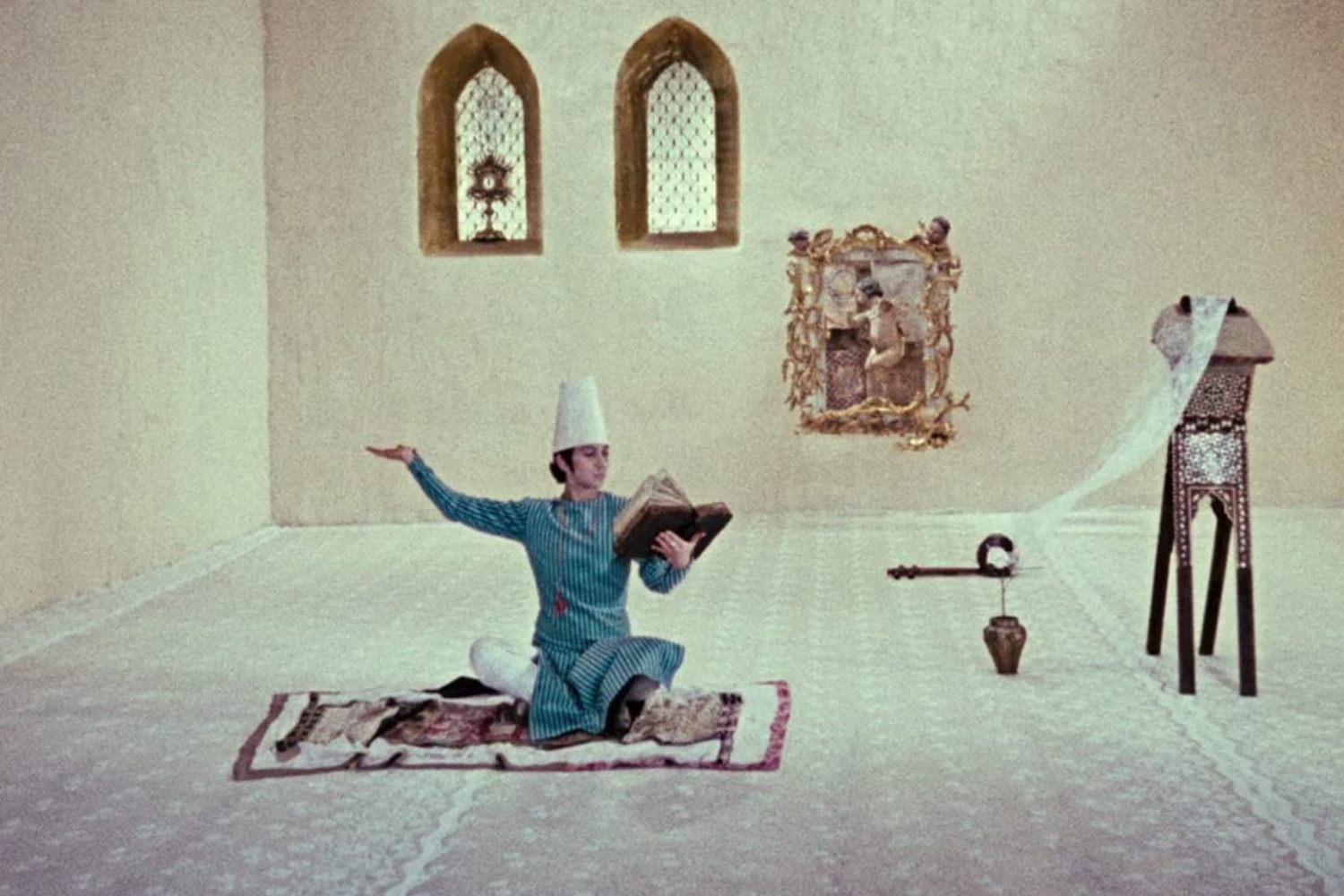

+ Google Map
pay what you wish
Get Tickets
Beginning in its inaugural year in 1967, the Shiraz Arts Festival treated audiences to daily film screenings, drawing enthusiastic crowds, particularly among the younger demographic. Initially held at the Paramount and Capri cinemas, the festival later found its home at the Ariana Theatre, a state-of-the-art venue owned and operated by filmmaker Shahrokh Golestan, a native of Shiraz. The festival’s diverse lineup encompassed both classic and contemporary works, ranging from retrospectives of esteemed directors like Brook, Bergman, Buñuel, and Satyajit Ray to screenings of cutting-edge films by emerging Iranian talents and international auteurs.
One of the festival’s defining features was its thematic programming, which showcased a wide array of genres and topics. In 1970, for example, the festival delved into the theme of ‘theatre and ritual,’ presenting unfiltered glimpses of African rituals through the lens of French filmmaker Jean Rouch. Similarly, thematic showcases such as the 1975 presentation of musicals from Hollywood’s Golden Age and the 1977 exploration of Japanese cinema’s historical significance enriched the festival’s offerings and expanded its cultural impact.
Of particular note in the festival’s history was the premiere of Sergei Parajanov’s masterwork, “The Color of Pomegranates,” which took place amid significant anticipation and defiance of Soviet censorship. This groundbreaking film, along with other daring and thought-provoking selections like “Grass” and “Heir to Genghis Khan,” solidified the Shiraz Arts Festival’s reputation for showcasing groundbreaking cinema from around the world. Through its bold programming choices and pioneering spirit, the festival played a pivotal role in shaping the trajectory of Iranian cinema and leaving a lasting mark on the global film landscape.
This program features three films shown back to back. Opening the afternoon is William Greaves’ “The First World Festival of Black Arts”, a documentary film that celebrates a Shiraz-like festival that took place in the Senegalese capital of Dakar in 1966. Next shown will be a film shown at the Shiraz Arts Festival: Sergei Parajanov’s “The Color of Pomegranates”, a visually stunning exploration of the life and work of the Armenia poet Sayat-Nova. And closing the afternoon will be another film shown at the Shiraz Arts Festival – “Dayereh-ye Mina”, a film by Dariush Mehrjui, an Iranian filmmaker who was assassinated in October 2023.
PROGRAM
2:00pm: The First World Festival Of Negro Arts (Dir. William Greaves, American, 1966, 40min)
2:45pm: The Color of Pomegranates (Sergei Parajanov, 1969, Armenian, Georgian, 78 min)
4:00pm: Dayereh-ye Mina / The Mina Cycle (Dariush Mehrjui, 1975, Iran, 101 min)
This event is part of A UTOPIAN STAGE, an exhibition at Asian Arts Initiative from February 9 to March 30, 2024.
ABOUT THE FILMS
The First World Festival of Negro Arts (1968) 40 minutes
Writer/Director: William Greaves
Producer: Motion Picture and Television Service of the United States Information Agency
Cinematographer: Georges Bracher, William Greaves
Courtesy William Greaves Productions
William Greaves (1926 – 2014) was a Harlem-born American documentary filmmaker, writer, producer and a pioneer of African American filmmaking. His film The First World Festival of Negro Arts is a Black history treasure and documents the landscape of the seminal performance festival held in Dakar, Senegal, in 1966, one year prior to the inauguration of Shiraz-Persepolis. The festivals at Dakar and Shiraz-Persepolis shared a similar decolonising ethos. The film was officially commissioned to document the events that attracted over two thousand writers, artists and performers from Africa and the African diaspora, including: Duke Ellington, Langston Hughes, Alvin Ailey, Aime Cesaire, Leopold Senghor and other artists, performers and dignitaries from thirty countries.
Greaves began his career as a Broadway actor and a member of The Actor’s Studio. He later served as executive producer and co-host of the Black Journal television programme for which he was awarded an Emmy in 1970. His recent film, Ralph Bunche: An American Odyssey (2001), documents the life and historic achievements of Dr. Ralph Johnson Bunche (1903-1971) the legendary African American Nobel prize-winning, scholar turned statesman who contributed to international diplomacy, decolonization, peacekeeping, and human rights in pre-civil rights America. His film From these Roots (1974) provides an in-depth study of the Harlem Renaissance.
The Color of Pomegranates (1969) 78 minutes
Writer/Director: Sergei Paradjanov
Editors: Sergei Parajanov, M. Ponomarenko, S. Yutkevich
Cinematographer: Suren Shakhbazyan
Courtesy Parajanov-Vartanov Institute.
Sergei Paradjanov (1924 – 1990)was a Soviet film director of Armenian descent who made a substantial contribution to Soviet cinematography through Ukrainian, Armenian and Georgian cinema. He pioneered his own cinematic style by stepping outside socialist realism, which was the only sanctioned art style within the USSR. His filmmaking and controversial lifestyle meant he was persecuted with his films regularly banned by Soviet authorities between 1965 and 1973.
The Color of Pomegranates is based, in part, on the life and poetry of the eighteenth-century Armenian poet, Sayat Nova (‘The King of Song’). Sergei Parajanov writes, directs, edits, choreographs, designs and creates every aspect of the film. It remains a masterpiece of cinema on account of being devoid of dialogue or camera movement and for its alluring imagery. The film was not seen internationally until 1977 due to Soviet censorship. It was screened at the Festival of Arts, Shiraz-Persepolis in 1976 and subsequently smuggled to Paris where it was received to great acclaim.
Dayereh-ye Mina / The Cycle (1975) 101 minutes
Writer/Director: Dariush Mehrjui
Dariush Mehrjui (1939 – 2023) was an Iranian filmmaker and a member of the Iranian Academy of the Arts. Mehrjui was a founding member of the Iranian New Wave movement of the early 1970s, which also included directors Masoud Kimiai and Nasser Taqvai. His second film, The Cow (1969), is considered to be the first film of this movement. Most of his films are inspired by literature and adapted from Iranian and foreign novels and plays.
Dayereh-ye Mina / The Cycle, a harrowing tale of poverty and drug addiction in the slums in which people desperately sell their blood to survive, is based on Gholam-Hossein Sa’dei’s short story “Garbage Dump.” Banned due to objections from the Iranian Medical Association, The Cycle was shelved for three years before it was eventually shown at the Shiraz Arts Festival. The left saw the story of the poor selling contaminated blood for injection into new veins as a metaphor for the corruption of Pahlavis. For Mehrjui, however, this was more a candid investigation of a real problem, and it eventually helped inspire the formation of the Iranian Blood Transfusion Organization. The casting of the popular filmfarsi star Forouzan was controversial, but her fine performance proved the versatility of Iranian actors.
- This event has passed.

